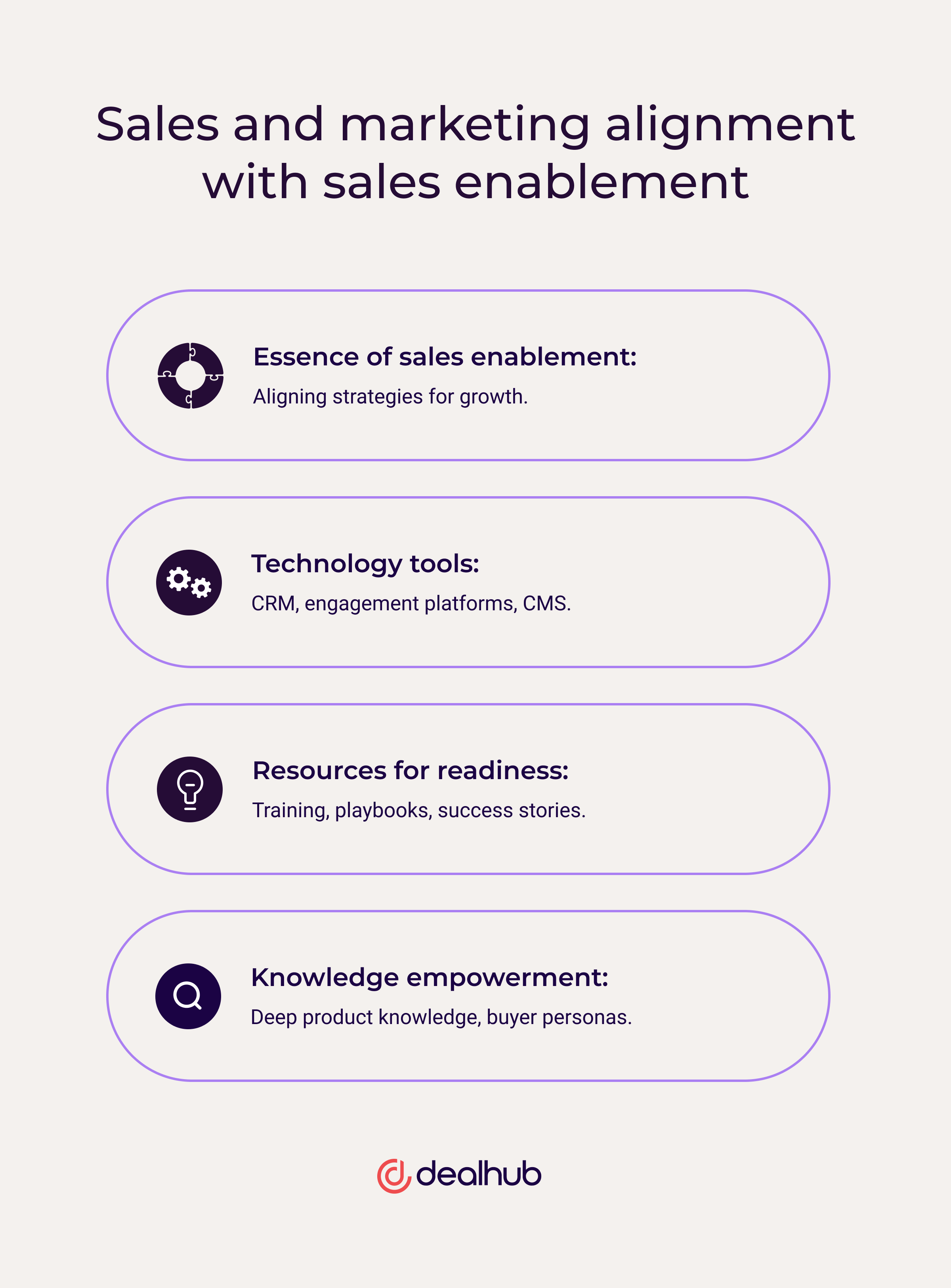To nail your sales enablement strategy, there are five crucial steps to consider. Moving through these five steps will allow you to develop effective best practices that will dictate purposeful growth. If you’re serious about enacting sales enablement, get ready to pick up a few essential tips and tricks.
Sales and marketing alignment: understanding sales enablement
Before we delve into the how-to of developing a robust sales enablement strategy, it’s important to understand what sales enablement is and why it matters.

At its core, sales enablement is the strategic alignment of sales and marketing efforts to drive business growth. It’s about providing your sales team with everything they need to effectively close deals. A strategic mix of tools, resources, and knowledge is necessary to build a winning sales enablement strategy:
Tools:
Technology plays an integral role in sales enablement, and many companies leverage solutions such as:
- Customer Relationship Management (CRM) systems to track leads, manage customers, and streamline the sales process.
- Sales engagement platforms to automate and streamline sales processes, including email campaigns, follow-ups, and prospect engagement.
- Content Management Systems (CMS) to organize and share marketing collateral and sales materials.
- Marketing automation tools to automate marketing tasks and nurture leads.
- Predictive analytics and AI tools to leverage data analytics and artificial intelligence for sales predictions and insights.
- Communication and collaboration tools to facilitate internal communication and collaboration among teams.
- Sales enablement tools to provide a centralized hub for sales resources and training.
Resources:
Resources provide teams with everything they need to land a sale.
- Training programs and workshops to equip teams with product knowledge, sales techniques, and industry insights.
- Sales playbooks to guide sales representatives with structured strategies and responses.
- Case studies and success stories to showcase real-world examples of successful deals and customer satisfaction.
- Sales collateral to provide visually appealing and informative materials for presentations and pitches.
- Competitive intelligence to keep sales teams informed about competitors and market trends.
Knowledge:
To gain confidence and effectively communicate with customers, sales teams must be equipped with a complete understanding of both the product and the audience. To achieve this, they need:
- Product and service knowledge to ensure that sales teams have in-depth knowledge about the products or services they are selling.
- Buyer persona understanding to tailor sales strategies directly to the target audience.
- Industry insights to stay informed about industry trends and changes.
- Sales methodologies to provide a structured approach to selling.
- Data analytics skills to analyze performance metrics and make data-driven decisions.
Sales enablement enhances sales performance by leveraging tools and knowledge while ensuring that your sales and marketing teams work hand-in-hand, speaking the same language and working towards shared objectives.
Building your sales enablement strategy

Creating a solid sales enablement program within your organization involves taking the above elements and weaving them into five essential steps:
Step 1: Align sales goals with business objectives
The first step for a successful sales enablement strategy is aligning your sales goals with your broader business objectives. This isn’t just about hitting sales targets; it’s about strategically positioning your sales efforts to contribute to the business’s overall success.
Start by identifying your company’s overarching goals. Is it market expansion, increased revenue, or launching a new product? Once you clearly understand these objectives, align your sales goals accordingly. For instance, if your business aims to increase customer retention, your sales goals might include upselling and cross-selling strategies.
There are many real-world examples to model your strategy around. For example:
HubSpot, an inbound marketing and sales platform, aligns its sales goals with the broader business objective of making inbound marketing accessible to businesses of all sizes. HubSpot’s sales teams use marketing to attract, engage, and delight customers through inbound strategies. HubSpot has achieved remarkable growth and market penetration by aligning sales goals with the overarching mission of democratizing inbound marketing.
Amazon, an e-commerce juggernaut, aligns its sales goals with its larger business objective of delivering an exceptional customer experience. From the user-friendly website interface to efficient logistics and customer support, every aspect of Amazon’s sales strategy is geared toward providing a seamless and enjoyable experience. Sales teams work in harmony with other departments to ensure customer-centricity is at the core of their operations.
Microsoft, a multinational software superstar, aligns its sales goals with its broader business objective of empowering individuals and organizations to achieve more. Microsoft’s sales teams cross and upsell across a suite of products and services that enable integrated productivity and innovation.
Step 2: Leverage technology for training and resources
Once you’ve zeroed in on your goals, it’s time to consider tools and training that get supercharged via technology. Consider e-learning platforms and virtual training tools to ensure your sales team has the latest knowledge and skills. Interactive and engaging content keeps them motivated and ready to tackle any challenge. Using technology as the delivery vehicle ensures it’s easy to offer uniform resources even if you have distributed or remote sales teams.
Integrate Customer Relationship Management (CRM) systems into your strategy. These systems provide invaluable data-driven insights and sales intelligence. Imagine having a tool that tracks leads and sales and guides your team on where to focus their efforts.
Other tech-driven approaches to sales empowerment include:
- Email and marketing automation
- Lead scoring
- Automated prospecting
- Guided selling
- Configure, Price, Quote (CPQ), and billing solutions
These technologies streamline processes to save time and make sales more efficient. That way, your team can focus on what they do best—closing deals.
Constant communication and mentoring are also essential. Having communication and collaboration tools in place so that sales and marketing teams can connect with one another, ask questions, and share insights is crucial. Equally important is providing feedback to sales teams. Mentoring, coaching programs, and training workshops can encourage personal growth. This will enable a sales force that’s knowledgeable, confident, and driven to deliver results.
Step 3: Prioritize cross-departmental alignment and collaboration
Sales enablement isn’t just the sales team’s responsibility—it’s a company-wide effort. When entire teams align around specific goals, results are much more impactful. Foster cross-departmental collaboration between sales, marketing, and product teams. Not only will goals align, but the knock-on benefit of more streamlined communication with customers will create seamless brand interactions.
To encourage communication, nurture an environment of knowledge sharing and teamwork. Focus on ways to provide the seamless hand-off of customers between departments, whether marketing, sales, or customer success. To do that, make sure you carefully map the buyer’s journey. Whether it’s sales collateral, playbooks, or customer success stories, provide content tailored for each stage. Then, ensure that every team has the right resources for every touchpoint.
Step 4: Continuous measurement and optimization
The success of your sales enablement strategy hinges on continuous measurement and optimization. Identify key performance indicators (KPIs) that align with your business objectives. Track metrics such as sales pipeline velocity, conversion rates, sales cycle length, win rates, deal size, and overall revenue to learn more about what’s working within your current strategy and use data to optimize it for future growth.
Technology again comes into play and can be integral to measuring and optimizing. BI solutions, AI, and predictive analytics can measure and study all available data to iterate on everything effectively, from marketing campaigns to sales approaches. A proactive approach to optimization ensures your strategy stays effective.
Step 5: Ensure sales team adoption
Even the most well-crafted sales enablement best practices are only effective if your sales team fully embraces it. Gain buy-in by involving your sales representatives in the development process. Provide ongoing support and resources, ensuring they feel confident and equipped to implement the strategy.
Share success stories within your organization to showcase the positive impact of sales enablement. When sales teams see tangible results, they are more likely to champion the strategy. Remember, it’s not just about implementing a strategy; it’s about creating a culture where sales enablement is woven seamlessly into daily operations.
Ready to take action?
Developing a robust sales enablement strategy is an ongoing process that requires adaptability and a commitment to continuous improvement. Remember to:
- Position your sales efforts strategically to contribute to overall business success.
- Embrace e-learning, CRM systems, and other tech solutions to empower your sales team.
- Foster a culture of teamwork with shared objectives across sales, marketing, and product teams.
- Track KPIs and adapt your strategy using real-time performance analytics.
- Involve your sales team, provide ongoing support, and celebrate success to drive employee buy-in.
Don’t forget: a successful sales enablement strategy is not a one-size-fits-all solution. Tailor these steps to fit the unique needs and goals of your organization. Stay agile, stay positive, provide the right tools and technology to nurture personal growth.









